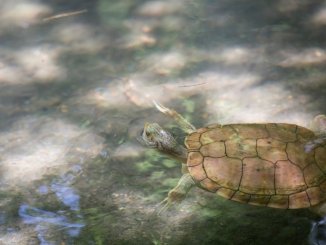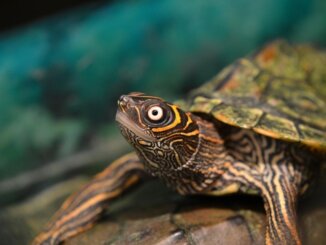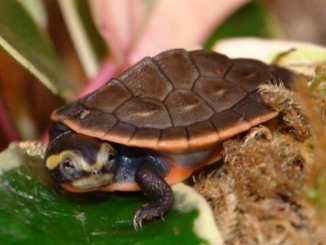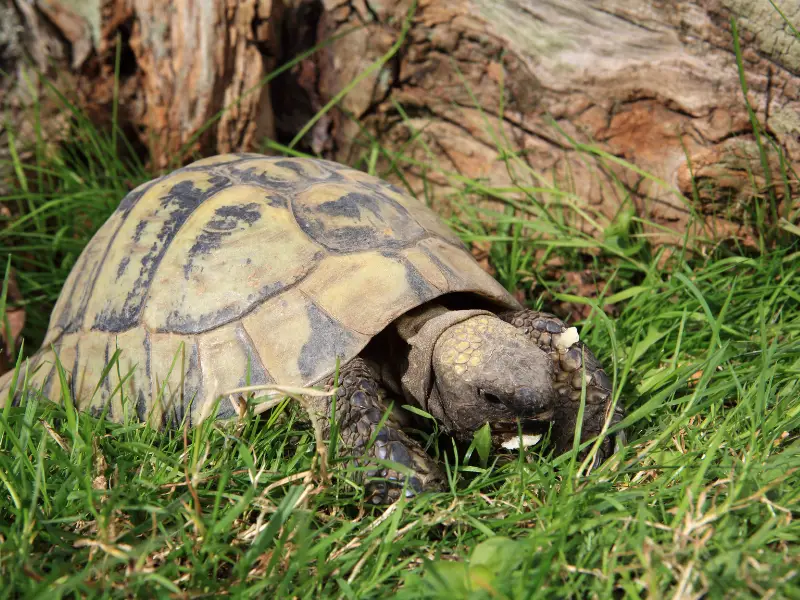
Famed throughout the reptile enthusiast world as being some of the most enjoyable herps to keep as pets, Testudo tortoises are plucky, easy to care for, and loaded with personality. Their diminutive size and curious, energetic natures make Testudos eminently suitable for educated and enthusiastic first-time tortoise owners.
Like others of their order, tortoises in genus Testudo are exceptionally long-lived, with many species outliving their human owners by several decades. Reptile owners often joke that you shouldn’t get a tortoise unless you’re prepared to write it into your will!
Keep reading to learn all about these lively and lovely little creatures, including how to prepare and what to expect if you’re interested in adding a Testudo tortoise to your family.
Quick Facts
| Common name | Palearctic tortoises, Mediterranean tortoises |
| Scientific name | Testudo (genus) |
| Adult size | 2¾–14" shell length, 1.5-15.5 pounds |
| Lifespan | 70 to 140 years or more (depending on species) |
| Diet | herbivorous (primarily leafy plants) |
| Tank size | 8'L x 4'W x 2.5'H or at least 32 square feet of floor space (about 40 gallons) |
| Humidity & temperature | 40-60% humidity; 70°F cool zone, 85-100°F basking area (depending on species) |
| Popular alternatives | Red-footed tortoise, leopard tortoise, African spurred tortoise |
What Is a Testudo Tortoise?
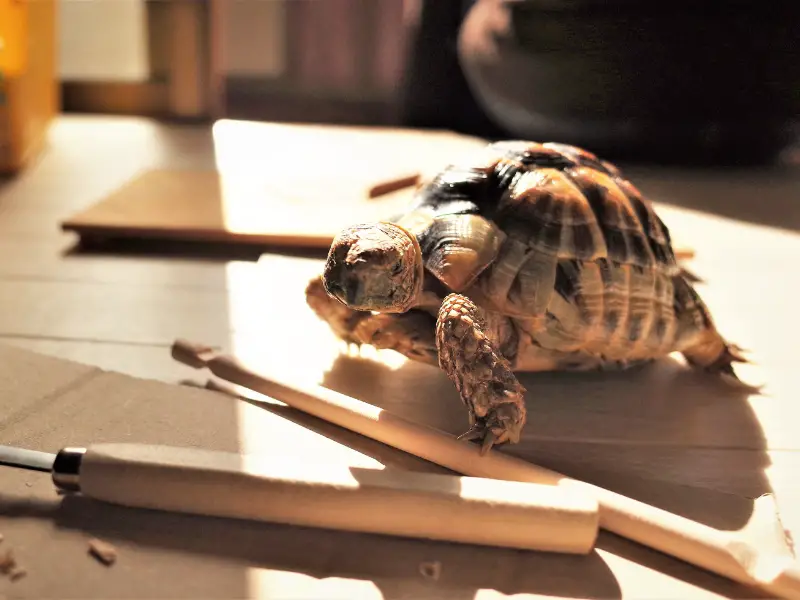
Testudo is the genus name for a group of tortoises native to North Africa, Western Asia, and Europe. These reptiles are typically on the small side, and many of them make excellent pets for first-time tortoise keepers due to their relative ease of care.
Since many of these species are endangered or threatened, would-be owners should source their pets from ethical breeders. All but one Testudo species are regulated under Article X of the Convention on International Trade in Endangered Species (CITES), meaning that importing and exporting wild-caught specimens and breeding unregistered adults is illegal.
Here are four tortoises in the genus Testudo that are popularly kept as pets in many parts of the world.
Greek Tortoise
The Greek tortoise (Testudo graeca), also called the spur-thighed tortoise, is an easygoing and popular companion. There are many subspecies of T. graeca, though T. graeca iberia is by far the most common in the exotic pet industry.
Thanks to their genetic diversity, Greek tortoises’ shells come in a variety of colors, patterns, and shapes. They can vary in size as well, though females typically don’t exceed five and a half pounds, and males are somewhat smaller.
Greek tortoises can live up to 125 years in captivity. Unverified reports suggest they may be capable of living for 200 years or even longer!
Russian Tortoise
Testudo horsfieldii is a charming and personable reptile endemic to Central Asia. It’s commonly referred to as the Afghan tortoise, four-clawed tortoise, Russian steppe tortoise, and Horsfield’s tortoise.
Russian tortoises are the only Testudo species that can be bred and imported to CITES-adherent nations without an Article X certificate. They are also the shortest-living Testudo tortoises – though their 50-year expected lifespan is nothing to sneeze at.
On September 18, 1968, two Russian tortoises aboard the Soviet spacecraft Zond 5 became the first Earthlings to orbit the moon – a distinction they shared with a few plants, fruit fly eggs, mealworms, and, of course, bacteria. Despite a rough re-entry into our atmosphere, the tortoises were proclaimed to be active and healthy after their post-mission examination.
Hermann’s Tortoise
Hermann’s is considered a small-to-medium-sized tortoise, with adults reaching 2.8 to 7.1 inches in length and seldom weighing more than nine pounds.
Testudo hermanni boasts a striking black-and-yellow shell pattern that is often more saturated and intense than that of other tortoises in the genus. Otherwise, it bears a great resemblance to the Greek tortoise, though several small signifiers can be used to tell the two apart.
| Greek Tortoise | Hermann’s Tortoise |
| Large scales on head and front legs | Small scales on head and legs |
| Uniform shell over the tail | Shell almost always has a cleft over the tail |
| Significant thigh spurs | No thigh spurs |
| No tail spur | Spur at the tip of the tail |
Hermann’s tortoises are popular pets due to their small size and sociable natures. A Hermann’s tortoise that lives to adulthood in the wild has a life expectancy of around 30 years. In captivity, these reptiles have been known to live as long as 70 years and could reach 90 or older with excellent care.
Marginated Tortoise
The largest Testudo tortoise, the marginated tortoise (Testudo marginata), is also the most distinctive-looking. Adults of this species weigh up to 11 pounds on average with a shell length of 14 inches, though larger specimens are possible.
The marginated tortoise’s claim to fame is its striking carapace, which boasts several large, flat, jagged “saw-tooth” segments jutting from the rear. These animals are relatively calm and mild, with seasoned keepers describing them as “slow to anger.” However, if they aren’t fed the right diet, these tortoises can become aggressive and more likely to attack in self-defense.
Their dramatic shells and respectable yet manageable size make marginated tortoises the ideal pet for herp enthusiasts who have plenty of room for their charges to roam around.
Testudo Tortoise Care Sheet
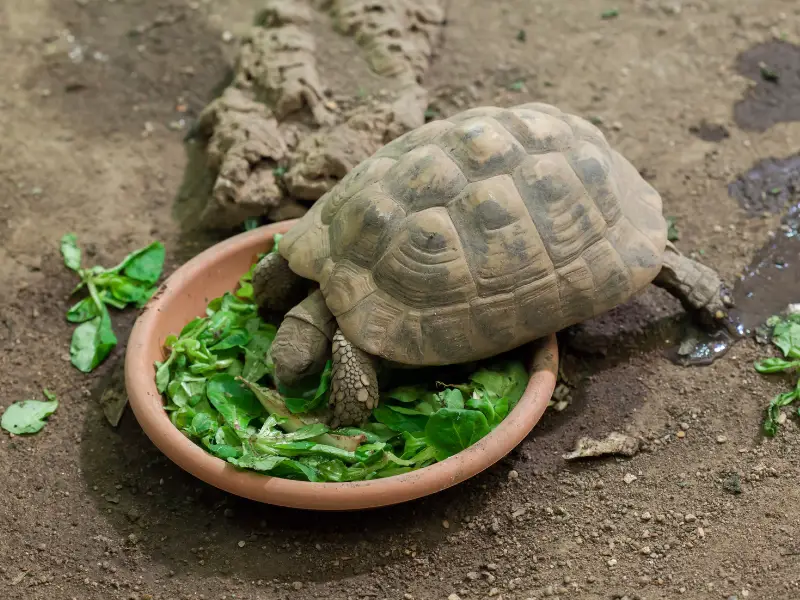
All reptiles have specific requirements when it comes to the size, temperature, and humidity of their tank environments and enclosures. Straying from these parameters can lead to sick and unhealthy animals, so it’s crucial to monitor your tank setup at all times.
Before adopting any pet, you should have a solid grasp on what it eats, how much exercise it needs, and whether it might be happier living with a friend or two of the same species.
Let’s dive into the specifics of Testudo tortoise care!
Tank and Enclosure
Testudos can be kept either indoors or outdoors. Depending on your local climate, you may need to bring your animals inside during the winter or summer to prevent them from getting too cold.
As with all tortoise species, the enclosure’s floor space is more important than its height. Turtles rarely climb much, but they do like to roam around. Testudo tortoises tend to be more active than larger tortoises, and they need plenty of space to wander, so they don’t feel constricted.
If you’re keeping your tortoises indoors, their tank should have at least 32 square feet of floor space – that’s eight feet long by four feet wide. The tank doesn’t have to be particularly tall; about two and a half feet will do.
The tank should be kept between 75 and 85 degrees Fahrenheit. Maintain a “cool zone” at about 70 degrees, and provide a basking area that reaches 90-100 degrees.
Since they’re native to arid areas, Testudos prefer moderate humidity, between 40-60%. They like mixtures of mulch, wood shavings, and dirt for their substrate.
Though most Testudos are curious and active, even the most energetic ones need a break from the spotlight now and then. Make sure your new friend’s tank has a safe place to hide – other than his shell, of course.
If you live in an area where the weather is reliably 75 degrees or higher, you may be able to keep your Testudo outdoors. The enclosure needs to be covered completely with mesh to protect your tortoise from local predators. You’ll also need to bring your pet inside any time the weather goes below 65 degrees.
As a final note about outdoor enclosures, be sure to bury the pen’s walls at least six inches into the ground to prevent your tortoise from digging its way out.
Feeding
All Testudos are herbivorous, meaning vegetarian. That doesn’t mean you can feed them just any greens or vegetables, though; these guys have a pretty specific dietary regimen. They do best with high-fiber, low-protein diets.
The following are ideal Testudo foods:
- Dandelion greens
- Shredded carrots
- Endive
- Chopped up Timothy hay
- Zucchini
Most Testudos love fruit, but you should only give your friend this sweet snack every once in a while.
Feed your Testudo from a dish to prevent it from accidentally swallowing its substrate along with the meal.
Tortoises use their water bowls for three purposes: drinking, bathing, and going to the bathroom. Consequently, the bowl needs to be big enough to accommodate your tortoise’s whole body, and you’ll need to change the water every day to keep things clean and hygienic.
Health and Wellness
Like all shelled animals, Testudos are prone to shell rot, a disease caused by a fungus that can lead to painful warping of the shell if not corrected swiftly. They can also develop a metabolic bone disease if they don’t get enough calcium in their diets.
It’ll be hard to resist because of how small and cute your new pal is, but you should avoid handling your Testudo as much as possible. Shelled reptiles are particularly stressed out by overhandling, and they can develop health and behavioral issues if their boundaries aren’t respected.
Before you bring your first reptile home, find a veterinarian near you who specializes in exotic pets. You’ll need someone in your corner with experience diagnosing and treating tortoises to ensure your friend has a long and happy life.
Testudo Tortoise Behavior
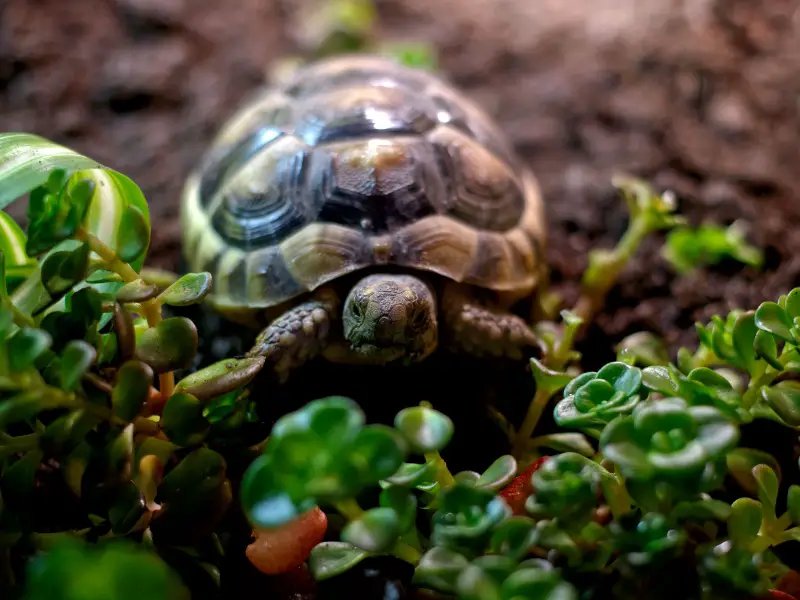
Outside of the mating season, Testudos tend to be very agreeable and easygoing animals. They often become friendly with their owners as long as they aren’t picked up too much, even walking up to their favorite humans unprompted.
Socialization
In the wild, Testudo tortoises spend most of their time alone. Captive Testudos don’t necessarily need friends in order to stay happy; in fact, having a tankmate could end up stressing them out.
If you have your heart set on owning two or more Testudos, keep these guidelines in mind to ensure your animals are able to cohabitate safely and healthily.
- When keeping two tortoises in the same enclosure, the pen’s size should be twice the recommended dimensions for a single tortoise.
- Never keep two male tortoises in the same tank, as they will likely become aggressive and try to kill one another.
- Avoid keeping a single male tortoise with a single female tortoise; the male could become aggressive and hurt the female.
- Two female tortoises can usually cohabitate without issues.
As far as human socialization goes, your Testudo will learn to trust you and appreciate your presence as long as you feed it regularly and don’t try to handle it.
Hibernation
Like all cold-blooded animals, tortoises and turtles lack the ability to produce their own body heat, so those that live in variable climates enter a stasis-like state called “brumation” when the weather gets cold. This period can last anywhere from three to six months. Russian tortoises can brumate as long as nine months in the wild, depending on where they live.
Indoor tortoises with temperature-controlled environments likely won’t go into brumation on their own. Additionally, sick animals with respiratory infections and other ailments should be prevented from hibernating for their own safety.
Talk to your vet about your specific tortoise’s needs well in advance of your first winter together to ensure a safe and happy cold season for both of you.
Appearance
All Testudos have an attractive brown- or black-and-yellow shell pattern. The specific pattern varies depending on the species, but for all four popular Testudos, the colors will fade as the animal ages.
Testudos vary greatly in size and weight – not just from species to species but from individual to individual. The marginated tortoise is the biggest Testudo, with females growing as long as 14″ and weighing up to 15 pounds – though most are closer to 10″ long and 11 pounds.
If you want to raise a baby tortoise that has a reasonable chance of becoming a small adult, choose a male Hermann’s or Russian tortoise.
Testudo Tortoise Babies
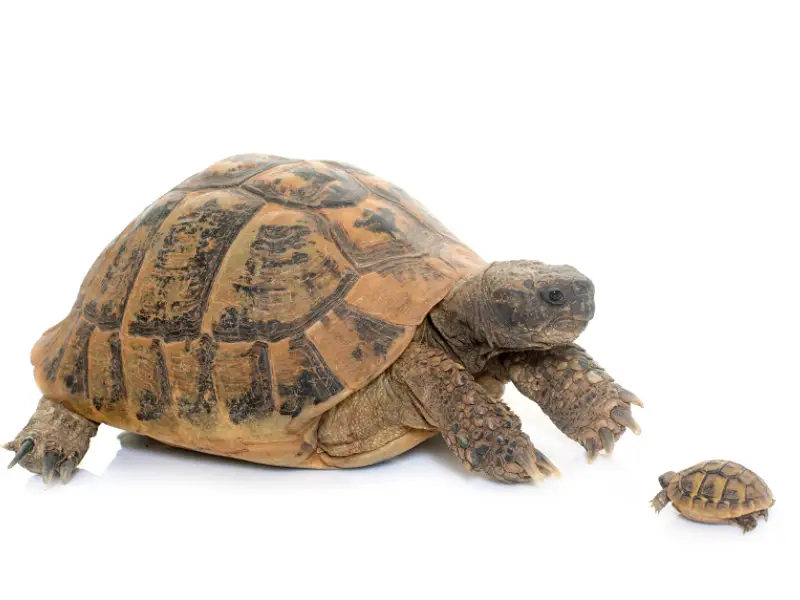
Is anything cuter than a tiny baby tortoise? Hatchlings are easy to fall in love with, and many people who see baby tortoises in their local pet shop become instantly smitten.
However, bringing home a baby Testudo is a commitment unlike adopting most other baby animals. Your tiny hatchling could easily live for the next fifty years – or seventy, one hundred, even two hundred! There’s a high probability you’ll need to have a plan for what happens to your beloved pet after you’re gone – a sobering proposition for an excited reptile parent-to-be.
Apart from that, raising Testudo tortoise babies requires a gentle touch and lots of patience. Young tortoises have soft shells until they’re six or eight years old, and many larger Testudos (like the marginated tortoise) don’t reach their full size until somewhere around the age of 20.
Since they haven’t fully grown into their “armor” yet, baby tortoises need lots of shade to shield them from their hot sun lamps. Their hiding areas should be humid to keep them hydrated and encourage shell growth. They also need a thick substrate layer for burrowing and hiding.
Under CDC guidelines, turtles and tortoises with a shell length of less than 4″ cannot be imported into the United States. That means wild-caught Testudo babies are illegal in the States. If you want to raise a Testudo tortoise from infancy, go through an accredited breeder rather than purchasing from a smuggler.
How Much Does a Testudo Tortoise Cost?
The price of a Testudo tortoise varies dramatically depending on the species, the reptile’s age, and where you’re located.
In the United States, you can expect to pay around $200 for a healthy baby Greek tortoise, $250-300 for a baby Russian tortoise, $300-500 for a baby marginated, and $250-400 for a baby Hermann’s tortoise.
In general, the smaller and more popular tortoise species cost less than the larger and less widespread reptiles. You’ll also pay much more for a juvenile or adult tortoise than you would for a hatchling.
Be wary of anyone offering these reptiles at a suspiciously low price. Most Testudo tortoise species are either endangered, threatened, or at risk of becoming threatened due to habitat destruction and illegal smuggling. If the price seems too good to be true, it’s likely the tortoise comes from an illegal and unethical source or that it’s a sickly animal with a low chance of survival.
Purchasing your new friend from a reputable breeder isn’t just the responsible thing to do: it also guarantees you a healthy, happy animal you’ll have by your side for decades to come.
Care Guide Summary
Small, hardy, and full of personality, tortoises in the Testudo genus are enduringly popular pets. Greek tortoises, in particular, are noted as being an excellent “gateway tortoise” for anyone looking to get into reptile husbandry.
As with any herp, Testudo tortoises require specific heat and humidity conditions in order to thrive. They need a clean water source, a hot place to bask, and a lot of floor space so they can roam. You’ll need to feed your tortoise a mix of dark leafy greens and vegetables to ensure they get all the necessary vitamins and minerals they need.
If you have the resources and household space for a scaly four-legged friend with an active lifestyle, a Testudo tortoise might be your perfect match.

